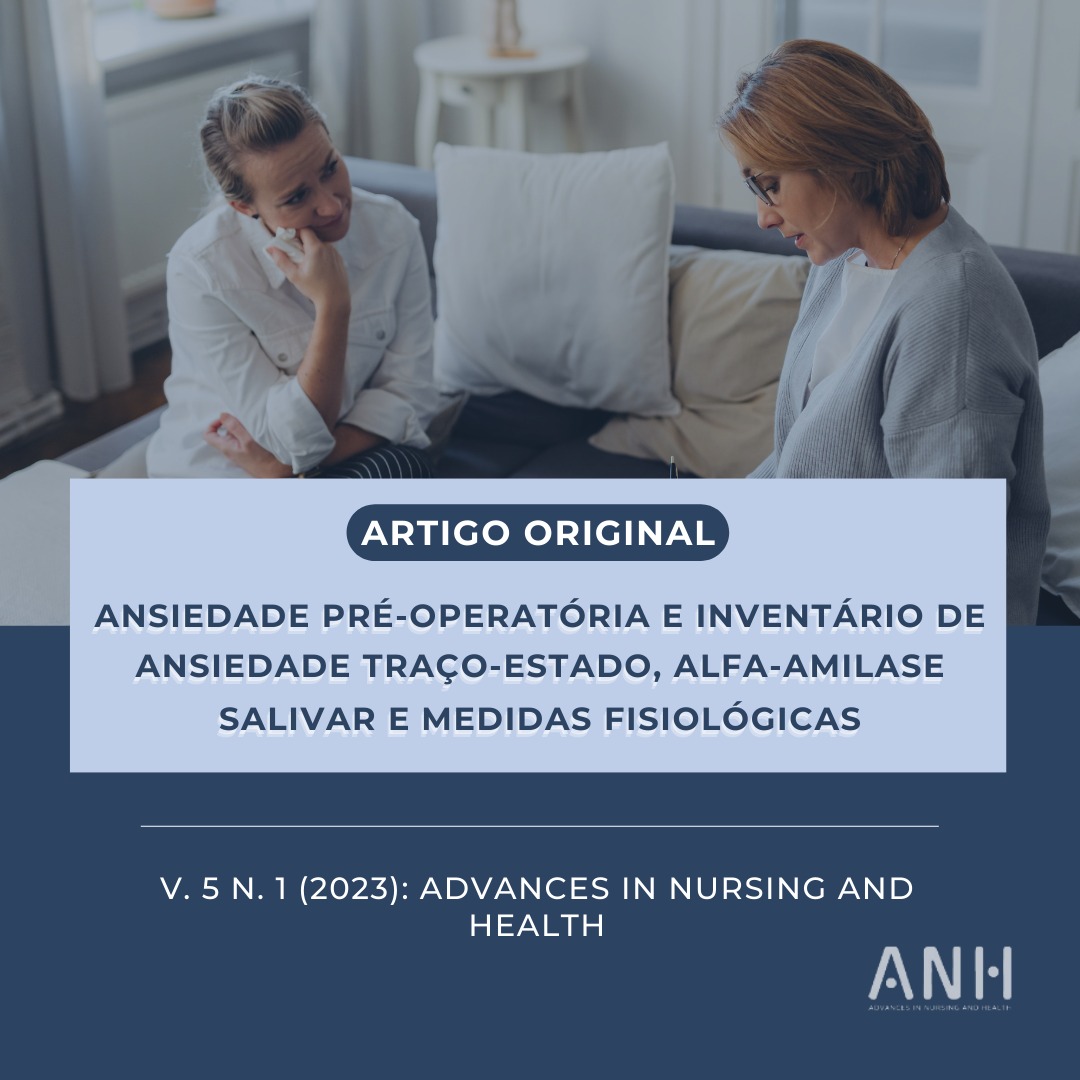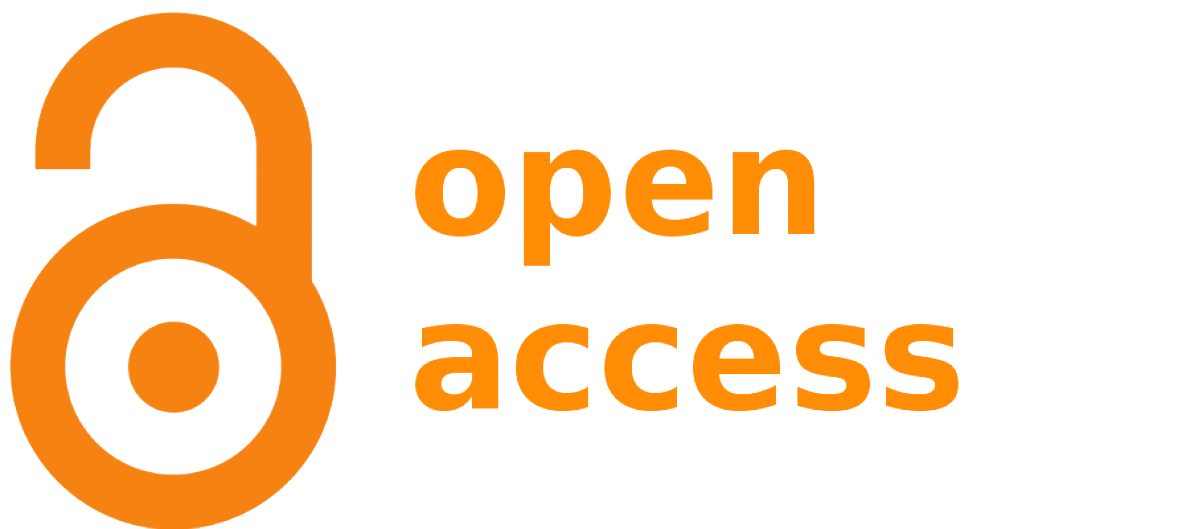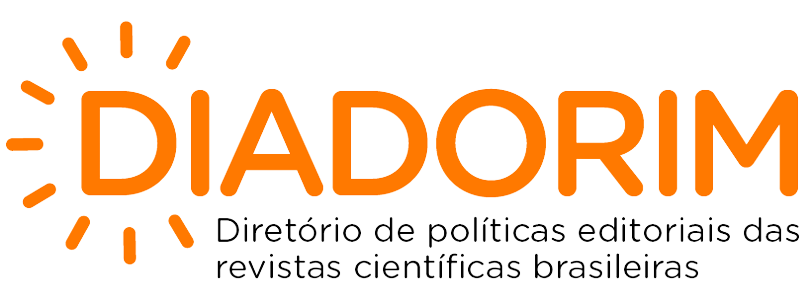PREOPERATIVE ANXIETY AND STATE-TRAIT ANXIETY INVENTORY, SALIVARY ALPHA-AMYLASE, AND PHYSIOLOGIC MEASUREMENTS
PREOPERATIVE ANXIETY AND STATE-TRAIT ANXIETY INVENTORY, SALIVARY ALPHA-AMYLASE, AND PHYSIOLOGIC MEASUREMENTS
DOI:
https://doi.org/10.5433/anh.2023v5.id46302Keywords:
Ansiedade, Escalas, Biomarcadores, Procedimento Cirúrgico Eletivo, Período Pré-operatórioAbstract
Objectives: To evaluate the presence of anxiety in individuals in the immediate preoperative period by applying the short version of the State-Trait Anxiety Inventory and measure the biomarker salivary alpha-amylase and physiologic parameters to verify the existence of an association between them and the effects of using psychotropic medications to control anxiety. Methods: Observational, analytical, and longitudinal study with 64 patients in their immediate preoperative period who would have elective mid-size surgeries. Anxiety was assessed by applying the short version of the State-Trait Anxiety Inventory (short version) and measuring the biomarker salivary alpha- amylase and physiologic parameters (systolic and diastolic blood pressure and heart rate) at two times: after admission of the patient to the infirmary and one hour before they were taken to the operating room. Results: there was a statistically significant difference between the results obtained at the two times for the Inventory and systolic and diastolic blood pressure (p = 0.17), as well as salivary alpha-amylase and use of psychotropic medications (p = 0.002). Additionally, a correlation was found between the differences measured by means of the Inventory at the two times and age (p = 0.003). Conclusion: the patients had anxiety during the immediate preoperative period. Use of psychotropic drugs showed a direct relationship with decreased salivary alpha-amylase. The score in the short version of the State-Trait Anxiety Inventory (short version) decreased as patient age increased.
Downloads
References
2. Maluf EMC, Richlin CH, Barreira MA. Prevalence of anxiety and depression in preoperative of elective surgeries at a university hospital in Curitiba. Rev. Med. UFPR. 2015; 2(2):62-6. https://doi.org/10.5380/rmu.v2i2.41386.
3. Melchior LMR, Barreto RASS, Prado MA, Caetano KAA, Bezerra ALQ, Souza TV. Predictors for moderate and serious pre-operative anxiety in hospitalized surgical patients. Enferm. glob. 2018;52:75-85. http://dx.doi.org/10.6018/eglobal.17.4.29.
4. Bedaso A, Ayalew M. Preoperative anxiety among adult patients undergoing elective surgery: a prospective survey at a general hospital in Ethiopia. Patient Saf Surg. 2019;13(18):2-8. https://doi.org/10.1186/s13037- 019-0198-0.
5. Akinsulore A, Owjuyigbe AM, Faponle AF, Fatoye FO. Assessment of preoperative and postoperative anxiety among elective major surgery patients in a tertiary hospital in Nigeria. Middle East J Anaesthesiol. 2015;23(2):235-40. https://pubmed.ncbi.nlm.nih.gov/26442401/.
6. Liu Y, Petrini MA. Effects of music therapy on pain, anxiety, and vital signs in patients after thoracic surgery. Complement Ther Med. 2015;23(5):714-8. https://doi.org/10.1016/j.ctim.2015.08.002.
7. Rocha RL, Alcântara CEP, Araújo CTP, Amorim VA, Oliveira-Ferreira F, Pinheiro MLP. Recognition and evaluation of anxiety in individuals with cerebral palsy during dental appointments. Arq Odontol. 2017;53:e02. http://docs.bvsalud.org/biblioref/2018/08/906067/10177-23226-1-sm.pdf.
8. Kaipper MB, Chachamovich E, Hidalgo MP, Torres IL, Caumo W. Evaluation of the structure of Brazilian State-Trait Anxiety Inventory using a Rash psychometric approach. J. Psychosom. Res. 2010;68(3):223-33. https://doi.org/10.1016/j.jpsychores.2009.09.013.
9. Yamaguchi M, Kanemori T, Kanemaru M, Takai N, Mizuno Y, Yoshida H. Performance evaluation of salivary amylase activity monitor. Biosens Bioelectron. 2004;20:491-7. https://doi.org/10.1016/j.bios.2004.02.012.
10. Mulrine BL, Sheehan MF, Burrell L, Matthews MD. Measuring stress and ability to recover from stress with salivary alpha-amylase levels. New Yor: United States Military Academy; 2011. https://apps.dtic.mil/sti/pdfs/ADA540975.pdf.
11. Ahmetovic-Djug J, Hasukic S, Djug H, Hasukic B, Jahic A. Impact of preoperative anxiety in patients on hemodynamic changes and a dose of anesthetic during induction of anesthesia. Med Arch. 2017;71(5): 330- 3. https://doi.org/10.5455/medarh.2017.71.330-333.
12. UÄŸraÅŸ GA, Yıldırım G, Yüksel S, Öztürkçü Y, Kuzdere M, Öztekin SD. The effect of different types of music on patients' preoperative anxiety: a randomized controlled trial. Complement Ther Clin Pract. 2018;31:158-63. https://doi.org/10.1016/j.ctcp.2018.02.012.
13. Hollander MHJ, Schorltingues J, Vissink A. Changes in heart rate during third molar surgery. Int J Oral Maxillofac Surg. 2016;45(12):1652-7. https://doi.org/10.1016/j.ijom.2016.08.004.
14. Potter PA, Perry AG. Fundamentos de enfermagem. 8ª ed. Rio de Janeiro (RJ): Elsevier; 2013.
15. Woldegerima YB, Fitwi GL, Yimer HT, Hailekiros AG. Prevalence and factors associated with preoperative anxiety among elective surgical patients at University of Gondar Hospital. Gondar, Northwest Ethiopia, 2017. A cross-sectional study. Int. J. Surg. Open. 2018;10:21-9. https://doi.org/10.1016/j.ijso.2017.11.001.
16. Machado JA, Silvia LF, Guedes MVC, Freitas MC, Ponte KMA, Silva AL. Autocontrole de ansiedade no pré-operatório cardíaco: resultado de uma intervenção de enfermagem. Sanare. 2015;14(2):36-42. https://sanare.emnuvens.com.br/sanare/article/view/822.
17. Abate SM, Chekol YA, Basu B. Global prevalence and determinants of preoperative anxiety among surgical patients: A systematic review and meta-analysis. Int. J. Surg. Open. 2020;25:6-16. https://doi.org/10.1016/j.ijso.2020.05.010.
18. Bedaso A, Ayalew M. Ansiedade pré-operatória entre pacientes adultos submetidos à cirurgia eletiva: uma pesquisa prospectiva em um hospital geral na Etiópia. Paciente Saf Surg. 2019;13:18. https://doi.org/10.1186/s13037-019-0198-0.
19. Ortiz J, Wang S, Elayda MA, Tolpinc DA. Preoperative patient education: can we improve satisfaction and reduce anxiety Rev. Bras. Anestesiol. 2015;65(1):7-13. https://doi.org/10.1016/j.bjan.2013.07.009.
20. Erkilic E, Kesimci E, Soykut C, Doger C, Gumus T, Kanbak O. Factors associated with preoperative anxiety levels of Turkish surgical patients: from a single center in Ankara. Patient Prefer Adherence. 2017;11:291-6. https://doi.org/10.2147/PPA.S127342.
21. Kanehisa M, Kawashima C, Nakanishi M, Okamoto K, Oshita H, Masuda K, et al. Gender differences in automatic thoughts and cortisol and alpha-amylase responses to acute psychosocial stress in patients with obsessive-compulsive personality disorder. J Affect Disord. 2017;217:1-7. https://doi.org/10.1016/j.jad.2017.03.057.
22. Leal PC, Goes TC, Silva LCF, Teixeira-Silva F. Trait vs. state anxiety in different threatening situations. Trends Psychiatry Psychother. 2017;39(3):147-57. https://doi.org/10.1590/2237-6089-2016-0044.
23. Szarmach J, Cubała WJ, Landowski J, Chrzanowska A. No relationship between baseline salivary alpha-amylase and State-Trait Anxiety Inventory Score in drug-naïve patients with short-illness-duration first episode major depressive disorder: An exploratory study. J Clin Exp Dent. 2017;9(4):e527-e530. https://doi.org/10.4317/jced.53631.
24. Kumar S. The effect of preoperative anxiety on postoperative pain. IJHW. 2015; 6(6):622-4. http://www.iahrw.com/index.php/home/journal_detail/19#list.
25. Bucx MJ, Krijtenburg P, Kox M. Preoperative use of anxiolytic-sedative agents; are we on the right track? J Clin Anesth. 2016;33:135-40. http://dx.doi.org/10.1016/j.jclinane.2016.03.025.
26. Bandeira RA, Gomes LO, Bezerra AJC, Duarte JA. Correlation between preoperative anxiety and acute postoperative pain in elderly patients submitted to transvesical prostatectomy. R Dor. 2017; 18(4):291-7. http://dx.doi.org/10.5935/1806-0013.20170118

Downloads
Published
How to Cite
Issue
Section
License
Copyright (c) 2023 Advances in Nursing and Health

This work is licensed under a Creative Commons Attribution 4.0 International License.
All or the content of the newspaper is licensed under a Creative Commons Attribution License, of the CC-BY attribution type.
Authors retain the copyright, and authors are asked to indicate first publication in this journal in the event of republication. Articles published in Advances in Nursing and Health are licensed under the Creative Commons Attribution 4.0 International License, which ensures Open Access. This license allows any user to read, download, copy, and share the content, as long as it is properly cited. It also permits the reuse of the material, including its distribution, adaptation, and creation of derivative works in any format or medium, provided appropriate credit is given, a link to the license is provided, and any changes made are indicated. In addition, the license allows commercial use of the content.


















